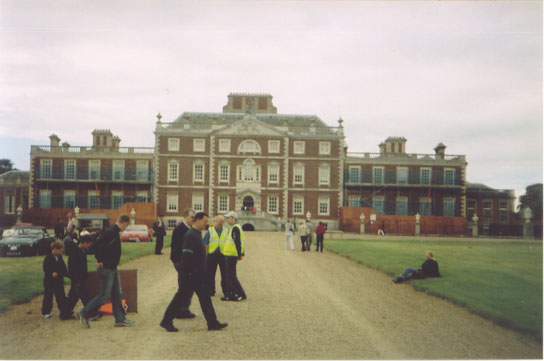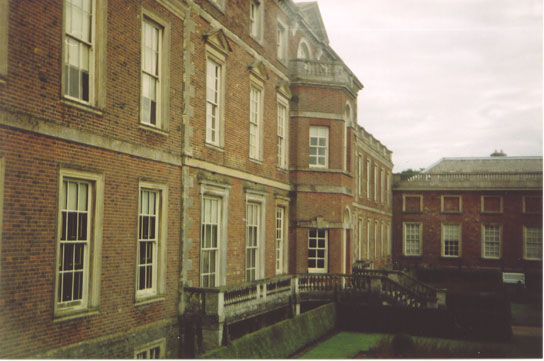National Trust.
This is a museum of curiousities, set in an exotic semi-tropical garden. The last owner of the house, scientist and inventor Otto Overbeck, filled the house with his collections. There is a cabinet devoted to his inventions, which include an electrical “Rejuvenator”, designed to inject new life into the old and tired by passing electricity through the body. Also in the museum is a “Polyphon” a music box using large sheet steel disks, which plays music encoded as punched holes, also display photographs of various shipwrecks, and under the stairs a collection of dolls’ houses. The garden has some very steep slopes, and views over coastline and estuary.
This isn’t the easiest place to get to, as the roads leading to it are single-track, steep and twisty, and not suited for anything bigger than a minibus. There is a small car park near the house, for visitors, and if it’s full, finding alternative parking could be troublesome. If you are feeling really fit, it’s possible to park at East Soar and walk up (2 miles), or walk up from the ferry (1/2 mile). The NT handbook cautions drivers against paying too much attention to one’s sat-nav and advises following the brown signs from Marlborough towards Salcombe. As I recall, it was steep and narrow the direct way and steep and twisty by the brown sign route, neither an easy drive.
Category: Parks & Gardens
Parks, gardens, landscape
Kelmarsh Hall Gardens, Northants.
The gardens were originally laid out by society decorator Nancy Lancaster in the 1930’s, and now have a Grade II* gardens listing from English Heritage, and are also a RHS Partner garden. It includes herbaceous borders, a rose garden, a walled kitchen garden, and a traditional greenhouse. Worth a visit if you like gardens at all.
The gardens are open several days a week in the warmer months.
Hatfield House, Herts.
Hatfield is one of the great treasure houses of England, with many fine rooms filled with art objects. Outside, there are several gardens, a maze, and also the Hatfield Old Palace, which elsewhere might be an attraction in its own right. The surviving wing of the Old Palace today consists of a great hall, used for functions. Don’t miss the viewing platform in the gardens which gives visitors a clearer view of the South Front. Asides from all that, there is the wider park and estate.
There is enough here for a half to full-day visit.
Waddesdon Manor, Bucks.
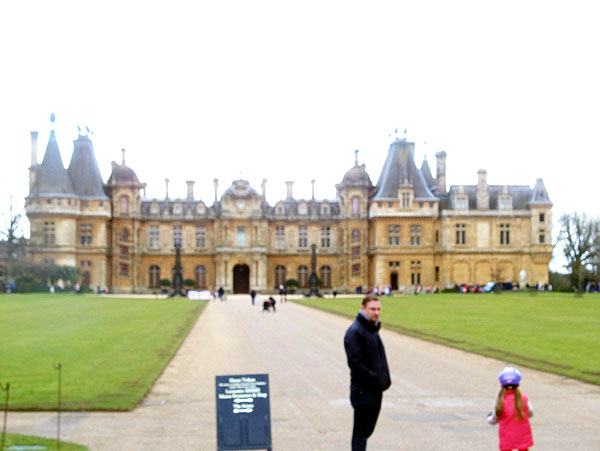 National Trust.
National Trust.
Waddesdon is one of several grand houses built by the Rothschilds (famous Jewish bankers). It was built in 1874-9 for Ferdinand de Rothschild, to a French design, and intentionally resembles a French Renaissance chateau. Ferdinand clearly dreamed of mansard roofs, pinnacles, massive chimneys, dormer windows and staircase towers. The pastiche chateau has similarly ornate French interiors, and Ferdinand was able to salvage panelling from the great Parisian houses demolished by Baron Haussmann to make way for the new boulevards. Needless to say, the furniture is also French. The rooms on the regular tour are full of treasures. The Batchelor’s Wing is not open at weekends, but contains smoking and billiard rooms, and even more treasures.
Outside, there is an entrance to the Rothschild wine cellars, some fine gardens and a wooded park. The formal parterre is to the south, and elsewhere is less formal well-planted parkland, the kind of terrain in which one can get lost trying to find the car park. There is a large 18th century style aviary housing exotic birds from over the world, and the grounds are dotted with contemporary sculptures.
With a total of 45 rooms on display, the visitor should allow enough time to see everything. At least a half-day visit is suggested.
As of Spring 2016, there is a large new hard-standing car-park on level ground, so that visitors no longer park on steep roadsides in the woods nearer to the house. The new car park is 15 minutes’ walk from the house, and free shuttle buses are provided.
Roadside signs and the free map indicate the way to Windmill Hill. This is not primarily a visitor attraction, but is the Rothchilds’ archive and conference centre. The buildings are an attractive set of Modernist structures set on a hilltop, on the site of the former Windmill Hill Dairy Farm, and complete with ornamental pool and modern sculptures, and a flat arch framing the view. The site is well worth a visit to snoop around the exterior and enjoy the architecture.
Rievaulx Terrace & Temples, Yorks
National Trust
The site is an artificial terrace of serpentine form, on a wooded escarpment overlooking the ruins of Rievaulx Abbey. Wide lawns are framed by banks of luxuriant flowers, and at either end of the terrace is a small temple. The Doric or Tuscan temple has flooring from the Abbey, and the Ionic temple at the other end was intended as a banqueting house and has elaborate interior décor. There is an exhibition in the Ionic Temple basement, in the former kitchen quarters. The terrace was constructed for Thomas Duncombe III, from the same family who owned Duncombe Park a mile away. Duncombe Park also has a formal terrace and temples, constructed earlier in about 1730.
The gardens are very pleasant, and worth a visit if you are touring in the area. Other attractions, e.g. Duncombe Park, Nunnington Hall, are nearby. In theory, the site overlooks the nearby Rievaulx Abbey below, but in practice the view (in 2005) is severly restricted by tree growth.
Knebworth House, Herts.
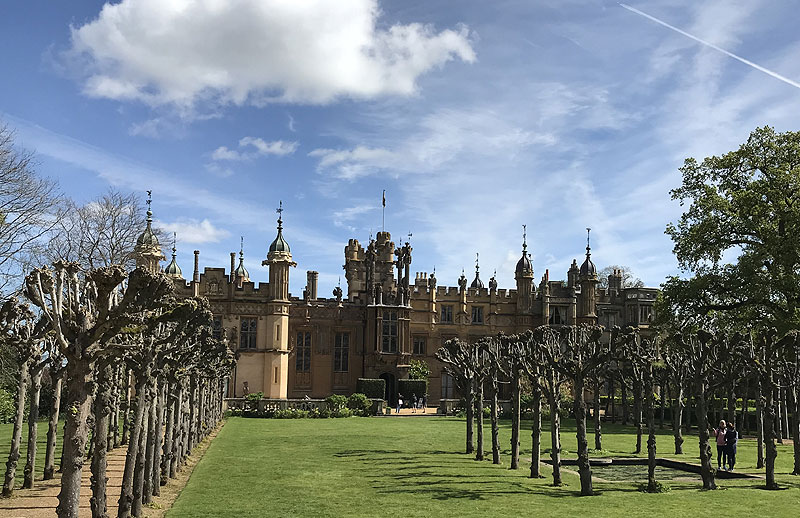 Private
Private
Knebworth House is famous for the rock concerts held in its park, and, by the more discerning, as the home of Victorian novelist Edward Bulwer Lytton – author of the words “The pen is mightier than the sword”. The house is mainly a Victorian Gothic creation, but a Tudor house was on the site before drastic remodelling in the 19th century. A liberal array of fancy domes and turrets are vividly contrasted with carved bats, griffins and grotesque gargoyles. Charles Dickens and Winston Churchill often visited the house.
Today’s visitor can see the Banqueting Hall, with its varied 17th century influences and craftsmanship, and other rooms of interest. There are two rooms entirely dedicated to the life and works of Sir Edward Bulwer-Lytton, with several personal knick knacks and mementoes highlighting his colourful character. The state drawing room is distinctly Victorian-Gothic, but other areas, including the dining parlour, are typical of the Edwardian re-styling adopted by Lutyens.
Outside there are 25 acres of gardens, including a walled kitchen garden and a dinosaur trail, and the church, as well as the park famed for its rock concerts. Scattered around the gardens are various large and small sculptures, mainly in wood.
Worth a visit, and you can divert yourself for at least half a day as there is plenty to look at. In my ill-spent youth I lived nearby and attended several rock concerts in the park.
It is worth visiting the exhibition in the couryard, which has memorabilia of the numerous movies filmed in the house and grounds, the rock concerts held in the park, and the family connections with Imperial India.
First visit 2005. All photos 2024.
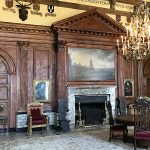
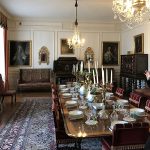
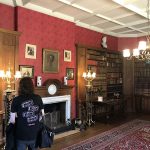
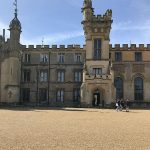
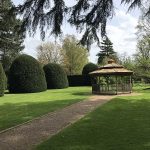
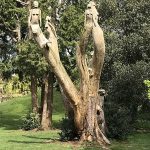


Hardwick Hall, Derbyshire
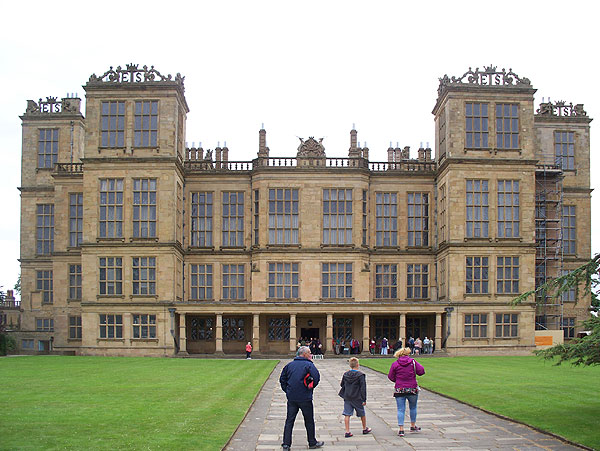 National Trust.
National Trust.
Hardwick Hall is one of the best-known of the NT houses. This Elizabethan house stands on a hilltop, looking big, smart, symmetrical and impressive. The tag “Hardwick Hall, more window than wall” was coined to describe it, and indeed it seems to have a window/wall ratio rather greater than that of my Victorian house and more typical of a public building. The design looks timeless owing to this particular look being copied in later centuries. Everything about the place seems calculated to impress by its size and grandeur. There are at least two big stone staircases, and on ascending one of them, one enters the High Great Chamber on the second floor. This is a very big and very high room and lavishly decorated, the Elizabethan decorations being largely unchanged. There is also a long gallery which is quite high and very long, and crammed with 80 portraits.
In the Dining Room the Sea-dog table is supported by four superbly carved chimeras and four tortoises.
The first floor rooms are now all open to visitors. The house has six towers incorporated in the structure, and atop the towers are the initials of the house’s first owner, Elizabeth Shrewsbury, in letters at least six feet high.
Close by are the ruins of Harwick Old Hall (English Heritage), which is in fact little older than the new Hall, but was allowed to fall into disrepair in more recent years.
Don’t miss a chance to visit. A visit to both Halls and their grounds will occupy several hours. Nearby on the Hardwick estate is Stainsby Mill (NT), a water-mill in working order. (revisited July 2017)
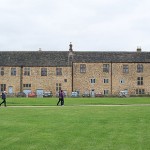
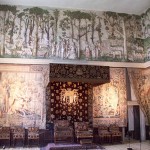
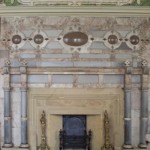
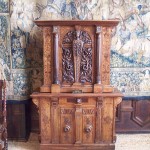
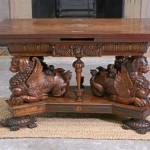
Fountains Abbey, Yorks.
National Trust & English Heritage
Fountains Abbey is now rated as a World Heritage Site. The abbey ruins are unusually complete, with many parts standing at near their original height. Perhaps the site was too remote to be extensively pillaged for building stone. There is much to see and do on site. Besides exploring the extensive abbey ruins, you can explore the beautifully landscaped Georgian water garden of Studley Royal, and visit Elizabethan Fountains Hall, the Cistercian monastery corn mill, and St Mary’s Church.
The gardens have a lake and many temples and follies, and even a twisting tunnel designed to give visitors a mild scare. If you are a fan of William Burges, do not miss the Victorian church, which looks plain on the outside, but inside is a riot of Victorian Gothic colour and carved ornamentation in wood and stone.
You should plan for an all-day visit.
Duncombe Park, Yorks.
The house, flanked by two large square service wings, is set in extensive parkland. The house was completed in 1713 and remodelled in 1843. The central block was gutted by fire in 1879 and not rebuilt till 1895, with a slightly revised layout.
I visited Duncombe Park in 2005. Inside, there is the Stone Hall, a lavishly decorated forty-foot cube, and other fine rooms with period furnishings. The house is no longer open to the public, but you can still visit the park and gardens, which are open several days a week during the warmer months.
(If you are curious to see what the house is like inside, check Weddings/Ceremony Locations on the Park website, or enquire about the Special Events.)
The gardens are quite extensive and include two temples, a large formal terrace, and a ruined conservatory.
Wimpole Hall & Estate, Cambs.
